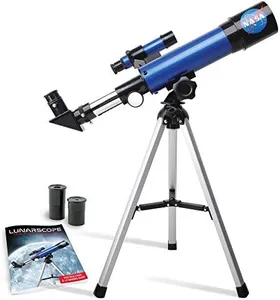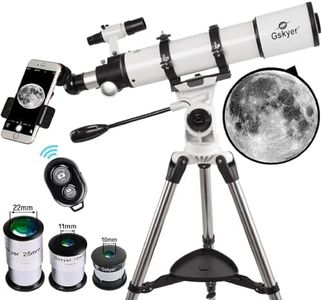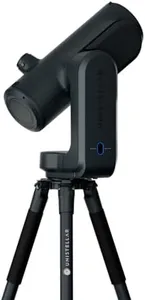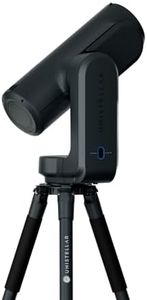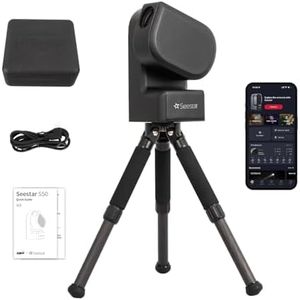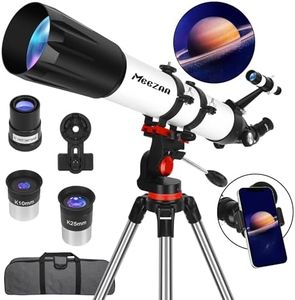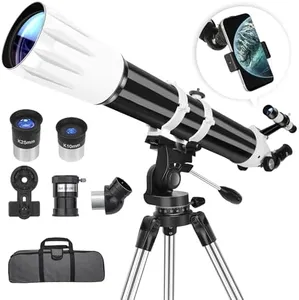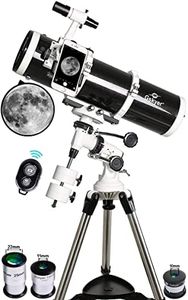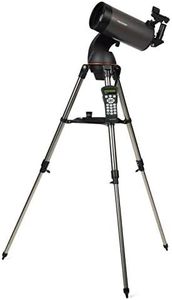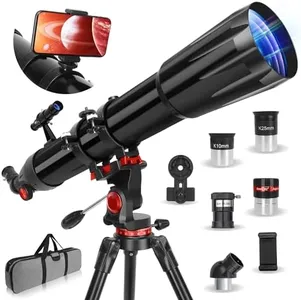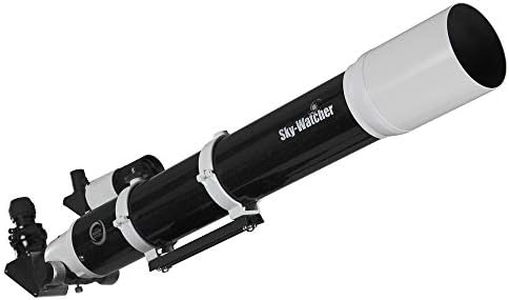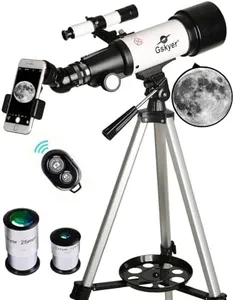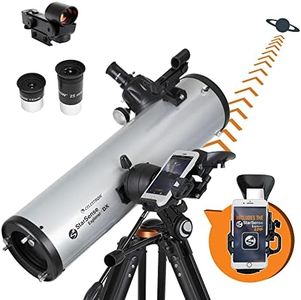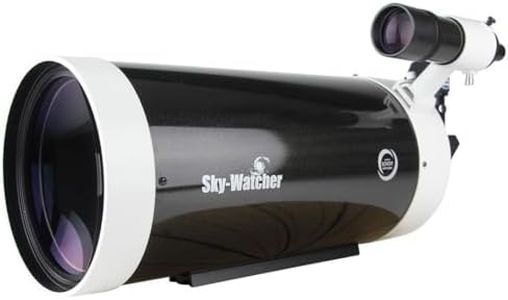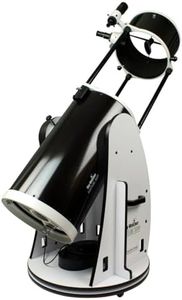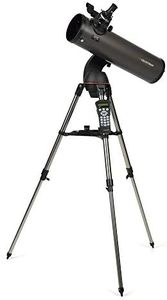10 Best Astronomical Telescopes 2025 in the United States
Our technology thoroughly searches through the online shopping world, reviewing hundreds of sites. We then process and analyze this information, updating in real-time to bring you the latest top-rated products. This way, you always get the best and most current options available.

Our Top Picks
Winner
Gskyer Telescope 600x90mm AZ Astronomical Refractor Telescope for Adults Astronomy, German Technology Scope
Most important from
22092 reviews
The Gskyer Telescope 600x90mm AZ Astronomical Refractor Telescope is a solid choice for adults interested in astronomy. Its key strength lies in its high-quality optics with a 600mm focal length and a 90mm aperture, allowing for clear and detailed images of the night sky. The fully coated optics glass lens enhances image quality and protects your eyes.
The telescope also offers high magnification options with three replaceable eyepieces (24X, 60X, and 120X) and a 3x Barlow lens that triples the magnifying power of each eyepiece, making it suitable for viewing a variety of celestial objects. The adjustable aluminum tripod provides flexibility in viewing positions, with a height range from 31.5 inches to 49 inches. This makes it adaptable for different users and locations.
The telescope is user-friendly, requiring no tools for setup, which is ideal for beginners. However, its weight of 18 pounds might make it less portable compared to smaller models. The altazimuth mount is straightforward to use but may not offer the precision needed for advanced users who require more control over their viewing angles. Included accessories such as the reflex finderscope and manual focus add to the value. The product comes with a 12-month support warranty, which is reassuring for new users. Nonetheless, those seeking more advanced features or greater portability might need to consider other options.
Most important from
22092 reviews
Odyssey PRO - UNISTELLAR Smart Telescope (with Eyepiece), 85mm f/3.9 (320mm) Digital & Computerized, App-Controlled Motorized Alt-Az, Enhanced Vision, RAW/FITS Export, 64GB, 5h Battery (Black)
Most important from
37 reviews
The Odyssey PRO by UNISTELLAR is a smart telescope designed for ease of use and modern astronomy enthusiasts. It has an 85mm aperture and a 320mm focal length with a fast f/3.9 optical design, making it suitable for wide-field views and bright images of the Moon, planets, and many deep-sky objects. Its motorized Alt-Az mount with automatic alignment and GoTo functionality means you don’t need to fiddle with complicated setup or polar alignment. This feature is ideal for beginners or casual stargazers, especially those observing from urban or suburban locations where quick setup is a plus.
A standout feature is its app-controlled system combined with an eyepiece that provides both a direct viewing experience and digital imaging. You can observe through the eyepiece or stream images to your phone or tablet, adding flexibility. The built-in 64GB storage and 5-hour battery life support extended sessions without needing extra gear. Additionally, it allows exporting RAW and FITS data, which benefits users wanting to do more advanced image processing or contribute to citizen science projects.
On the portability side, the telescope weighs about 6.5 kg (14.3 lbs) and includes a premium 2.5 kg tripod, making it reasonably portable but not ultra-lightweight. It fits well for users who want a balance between performance and mobility. The autofocus feature helps with image clarity, reducing manual adjustments. The 85mm aperture is moderate and limits the amount of detail visible compared to larger telescopes, especially under light-polluted skies. While the fast f/3.9 optics are great for wide views, they may show some edge distortion typical of short focal length lenses. The motorized Alt-Az mount is user-friendly but less suited for long-exposure astrophotography compared to equatorial mounts. In summary, the Odyssey PRO is a well-rounded smart telescope perfect for beginners and intermediate users seeking a digital, easy-to-use system that blends traditional eyepiece viewing with advanced app features. It is less ideal for those wanting large aperture or professional-level astrophotography but excels in convenience, portability, and engagement with citizen science.
Most important from
37 reviews
Odyssey - UNISTELLAR Smart Telescope (no Eyepiece), 85mm f/3.9 (320mm) Digital & Computerized, App-Controlled Motorized Alt-Az, Enhanced Vision, RAW/FITS Export, 64GB, Tripod, 5h Battery (Black)
Most important from
37 reviews
The Odyssey - UNISTELLAR Smart Telescope is a highly user-friendly option for people wanting to explore the night sky without fuss. It features an 85mm aperture and a 320mm focal length with an f/3.9 ratio, which provides a good balance of light-gathering and a moderately wide field of view—ideal for beginners and casual stargazers. The motorized Alt-Azimuth mount with one-click GoTo makes pointing the telescope easy and fast, eliminating the need for manual alignment.
Its autofocus and app control mean you operate and view directly through your smartphone or tablet, which is great for quick setup and group sharing but may disappoint those who prefer traditional eyepiece viewing. Portability is a plus here: the compact 4 kg telescope paired with a sturdy 2.5 kg tripod and a 5-hour battery life make it convenient for use on balconies or trips to darker skies. Included 64GB storage and the ability to export raw data allow for more advanced image processing and participation in citizen science projects, adding unique value beyond casual observation.
The reliance on a digital screen may limit the authentic experience some users seek, and the relatively small 85mm aperture means it won’t capture very faint deep-sky objects as well as larger scopes. For those interested in an easy, tech-savvy introduction to astronomy with added educational benefits, this telescope is a strong contender.
Most important from
37 reviews
Buying Guide for the Best Astronomical Telescopes
Choosing the right astronomical telescope can be a thrilling yet daunting task, especially for beginners. The key to making the best choice is understanding the specifications that matter most and how they align with your observing goals. Whether you're interested in viewing planets, deep-sky objects, or just casual stargazing, knowing what to look for in a telescope will help you make an informed decision.FAQ
Most Popular Categories Right Now
